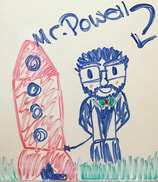|
In class today we finished our origami genes and also added to our genetics vocabulary list. Understanding the language of genetics is essential to being able to really understand how genetics work and make predictions about the genetic make up of organisms. Here are the words we added today.
Hybrid: Offspring receiving different alleles from each parent Dominant: The form of an allele that covers up the other form of an allele Recessive: The form of an allele that is covered up by the dominant allele Genotype: refers to the genetics make up of an organism (represented by pairs of letters TT, Tt, tt) Phenotype: The physical traits of an organism, more simply what an organism looks like (Tall, short) Homozygous: a pair of alleles that are the same AA, aa, BB, bb Heterozygous: When a pair of alleles are different Aa, Bb, Cc
0 Comments
Leave a Reply. |
AuthorMr. Powell is a High School Science Teacher in Western Colorado. Archives
May 2024
Categories
All
|

 RSS Feed
RSS Feed